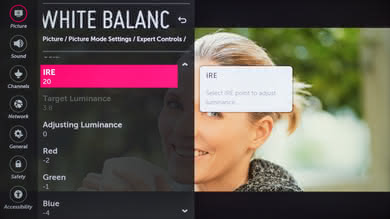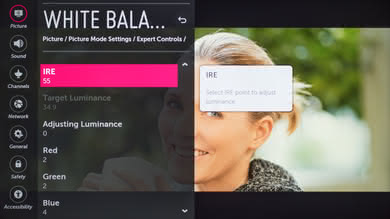Here are the following settings we've used for the calibration of the LG 75" UK6570 (75UK6570), and these should also work for the 70" variant (70UK6570), and the 86" variant (86UK6570). These should work for most content except for gaming which requires some minor changes, which we list below.
Eco Settings
Before starting our calibration, we disabled all eco settings. We set Energy Saving and Eye Comfort Mode to 'Off', as we don't want to artificially limit the brightness of the TV, or for the TV to change any settings while we are doing our testing.
General settings
The first thing we did was to select the 'ISF Expert (Dark Room)' picture mode. If you are in a bright room, this picture mode will probably be too dim. We select it because it is the most accurate picture mode. If you find it too dim, 'Standard' mode is a decent alternative. We set the Aspect Ratio Settings to '16:9' since we did not want our input to be stretched in any way. When watching lower resolution content you can adjust this setting to stretch the image depending on your preferences.
For review purposes and in our completely dark room, we adjusted Backlight to '31' to reach our desired luminance of 100 cd/m². Most people will find this too dim and should adjust it. Note that this does not affect the picture quality in any way, only the luminance of the display. We then set the Contrast to '90' and left Brightness to '50'. We also left Sharpness to '0', since we don't want to add any extra sharpening.
We left Color at '50' and Tint at '0', their default values.
In the Expert Controls settings page, we turned off Super Resolution, and Color Filter. Unlike most TVs we test, we recommend setting Dynamic Contrast to 'High', since without it, the UK6570 is far too dim. We set the Color Gamut to 'Auto', so the TV will switch the color gamut automatically to match the video source. The gamma was changed to 2.2, since it is the gamma that we aim for during calibration.
In the White Balance settings, we selected 'Warm2' from the Color Temperature settings since it is closest to our calibration goal.
In the Picture Options menu, we turned off Noise Reduction and MPEG Noise Reduction, but you can turn these on if you are watching older low-resolution content, as it may help reduce visual noise and compression artifacts. We set the Black Level to Low to match our source. When set wrong, blacks will look gray or may be crushed. We left Motion Eye Care off since we did not want the TV to change brightness automatically depending on the displayed scene. The Real Cinema option should be turned on if you are watching a 24p movie via a DVD or Blu-ray player in order to have a judder-free movie.
TruMotion is the motion interpolation option, commonly called the Soap Opera Effect. When watching low frame rate content like 24p movies the TV can insert extra frames to help motion appear smoother. Since this TV has a 60Hz panel the effectiveness of this is limited. The 86" model has a 120 Hz panel and can interpolate 60 fps content up to 120 fps. To enable it set TruMotion to 'User', and adjust the slider to add the level of desired soap opera effect. Higher levels of motion interpolation can cause artifacts in some scenes.
HDR settings
In HDR, we recommend the 'Standard' Picture Mode, as the other modes are too dim. If you still find HDR content too dim, it is recommended to set the Backlight to '100', and set Dynamic Contrast to 'High'. Without these settings, the UK6570 may appear far too dim, especially in the 'Game' and 'PC' Picture Modes.
For HDR to work properly with external devices, you may need to turn on HDMI ULTRA HD Deep Color for the HDMI port where you intend to connect your HDR UHD Blu-ray player or UHD game console, as some players may not detect that the TV can support the full HDMI bandwidth necessary for HDR content. Not that there is no difference between ports on the UK6570, and you can use any port for HDR content. Older devices might not work correctly if this setting is left on, so it is best to only enable it when you need it.
In HDR, some settings are a bit different. There are now 5 picture modes, and we recommend 'Standard (User)' for most content, or 'Game' when connected to a game console. In HDR it is recommended to set the Backlight to '100', Contrast to '100', and Brightness to '50'.
SDR and HDR Gaming settings
To get the best input lag possible when gaming whether you are in SDR or HDR, you need to set the Picture Mode to 'Game'.
Once the 'Game' picture mode is selected, some options won't be available in the settings menu as the TV disables most of the image processing to give better input lag. For 'Game' and 'PC' modes, the most accurate picture was obtained with Color Temperature set to 'W50', Color set to '50', and Dynamic Tone Mapping enabled.
Miscellaneous settings
If you want to activate Chroma subsampling (4:4:4) on the UK6570, you need to set the Input Label to 'PC' (from the input menu) for the HDMI port where your device is connected. For high bandwidth signals, be sure that the HDMI ULTRA HD Deep Color is also turned on.
White Balance Settings
The following are the results of the white balance and colorspace calibration on our unit. They are provided for reference, and should not be copied as the calibration values vary per individual unit even for the same model and same size as the TV we reviewed due to manufacturing tolerances. If you want to try them you will need to enter all values shown, as all of them are active at the same time. If you end up with worse picture quality, simply reset them to the default values.



















































































